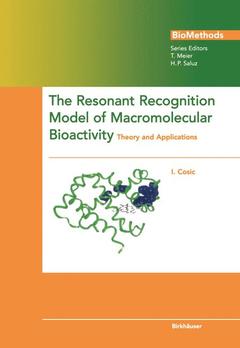The Resonant Recognition Model of Macromolecular Bioactivity, Softcover reprint of the original 1st ed. 1997 Theory and Applications Biomethods Series
Langue : Anglais
Coordonnateur : Cosic Irena

Biological processes in any living organism are based on selective interactions be tween particular biomolecules. In most cases, these interactions involve and are driven by proteins, which are the main conductors of any life process within the organism. The physical nature of these interactions is still not well known. This book presents an entirely new approach to analysis of biomolecular in teractions, in particular protein-protein and protein-DNA interactions, based on the assumption that these interactions are electromagnetic in nature. This new ap proach is the basis of the Resonant Recognition Model (RRM), which was devel oped over the last 15 years. Certain periodicities within the distribution of energies of delocalised electrons along a protein molecule are crucial to the protein's biological function, i.e. inter action with its target. If protein conductivity were introduced, then charges mov ing through the protein backbone might produce electromagnetic irradiation or ab sorption with spectral characteristics corresponding to energy distribution along the protein. The RRM is capable of calculating these spectral characteristics, which we hypothesized would be in the range of the infrared and visible light. These characteristics were confirmed with frequency characteristics obtained ex perimentally for certain light-induced biological processes.
1 Introduction.- 1.1 Structure-function relationships in proteins and DNA: definition of the problem.- 1.2 Existing approaches and their limitations.- 1.3 Novelty of the RRM model.- 1.4 Applications of the RRM.- 2 RRM Basic Concepts.- 2.1 Definition of macromolecular functional characteristics: characteristic frequency.- 2.2 Problems in FFT calculations within the RRM.- 3 The Physical Meaning of the RRM.- 3.1 Charge transfer through the protein backbone.- 3.2 Correlation of the RRM characteristic frequency with absorption spectra of light-absorbing proteins.- 3.3 Correlation of RRM characteristic frequency with low-intensity light effects on cell proliferation.- 3.4 Correlation between predicted and measured characteristic frequency of chymotrypsin activation.- 3.5 Photoreceptors with similar structures but different absorptions can be distinguished using the RRM.- 3.6 Frequency range of macromolecular interactions.- 4 Relation Between the RRM and 3D Protein Structures.- 4.1 Definition of “hot spots” in terms of the RRM.- 4.2 Example of heme-containing proteins.- 4.3 Discussion.- 5 Prediction of Functionally Active Sites and Functional Mutations.- 5.1 Hot spot predictions in DNA: example of the SV40 enhancer.- 5.2 Hot spot predictions in proteins: example of IL-2.- 5.3 Hot spot predictions in EGF.- 5.4 Active site prediction: example of protease-protease inhibitor interactions.- 5.5 Oncogenes and their activity: example of ras proteins.- 5.6 Definition of sequence function.- 6 Protein Interactions.- 6.1 Protein-protein interactions: frequency requirements.- 6.2 Protein-protein interactions: phase requirements.- 6.3 Protein-DNA interactions.- 7 Bioactive Peptide Design.- 7.1 Procedures: example of design of glucagon analogues.- 7.2 NGF analogue design and possibleapplications.- 7.3 Design of FGF analogues and application in limiting solid tumour growth.- 7.4 HIV-related peptides that mimic HIV immunogenicity.- 7.5 Activity of HIV-1-inhibiting peptides.- 7.6 New concept of HIV activity.- 8 Conclusions.- 8.1 New concept in molecular biology, new point of view.- 8.2 Advances in theory: macromolecular physics.- 8.3 Advances in molecular biology; design of new pharmaceuticals.- References.
This book presents an entirely new approach to the analysis of biomolecular interactions, in particular protein-protein and protein-DNA interactions. The Resonant Recognition Model (RRM), which has been developed by the author over the last 15 years, assumes that these interactions are electromagnetic in nature. Results presented in this book could help to resolve the fundamental question : what is the physical basis of macromolecular interactions and how are their specificity and selectivity achieved ?
Date de parution : 11-2012
Ouvrage de 148 p.
Thème de The Resonant Recognition Model of Macromolecular Bioactivity :
Mots-clés :
Biotechnology; biochemistry; chemistry; molecular medicine; protein; proteins
© 2024 LAVOISIER S.A.S.



